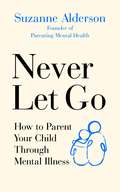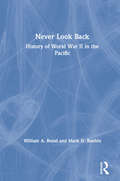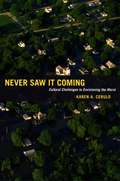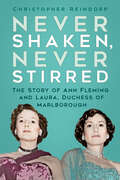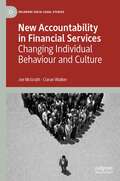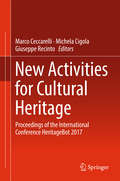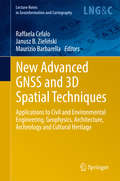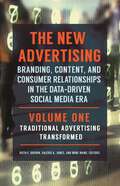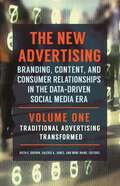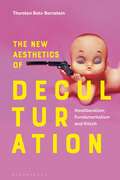- Table View
- List View
Never Had the Like Occurred: Egypt's View of its Past (Encounters with Ancient Egypt)
by John Tait"Never Had the Like Occurred" examines Ancient Egypt's own multifaceted encounters with its past. As Egyptian culture constantly changed and evolved, this book follows a chronological arrangement, from early Egypt to the attitudes of the Coptic population in the Byzantine Period. Within this framework, it asks what access the Egyptians had to information about the past, whether deliberately or accidentally acquired; what use was made of the past; what were the Egyptians attitudes to the past; what sense of past time did the Egyptians have; and what kinds of reverence for the past did they entertain? This is the first book dedicated to the whole range of these themes. It provides an explanatory context for the numerous previous studies that have dealt with particular sets of evidence, particular periods, or particular issues. It provides a case study of how civilizations may view and utilize their past.
Never Had the Like Occurred: Egypt's View of its Past (Encounters with Ancient Egypt)
by John Tait"Never Had the Like Occurred" examines Ancient Egypt's own multifaceted encounters with its past. As Egyptian culture constantly changed and evolved, this book follows a chronological arrangement, from early Egypt to the attitudes of the Coptic population in the Byzantine Period. Within this framework, it asks what access the Egyptians had to information about the past, whether deliberately or accidentally acquired; what use was made of the past; what were the Egyptians attitudes to the past; what sense of past time did the Egyptians have; and what kinds of reverence for the past did they entertain? This is the first book dedicated to the whole range of these themes. It provides an explanatory context for the numerous previous studies that have dealt with particular sets of evidence, particular periods, or particular issues. It provides a case study of how civilizations may view and utilize their past.
Never in Anger: Portrait of an Eskimo Family
by Jean L. BriggsIn the summer of 1963, anthropologist Jean Briggs journeyed to the Canadian Northwest Territories (now Nunavut) to begin a seventeen-month field study of the Utku, a small group of Inuit First Nations people who live at the mouth of the Back River, northwest of Hudson Bay. Living with a family as their “adopted” daughter—sharing their iglu during the winter and pitching her tent next to theirs in the summer—Briggs observed the emotional patterns of the Utku in the context of their daily life. In this perceptive and highly enjoyable volume the author presents a behavioral description of the Utku through a series of vignettes of individuals interacting with members of their family and with their neighbors. Finding herself at times the object of instruction, she describes the training of the child toward achievement of the proper adult personality and the handling of deviations from this desired behavior.
Never Let Go: How to Parent Your Child Through Mental Illness
by Suzanne AldersonHow to help your child with mental illness through partnering, not parenting.Never Let Go is a supportive and practical guide for parents looking after a child with a mental illness. Suzanne Alderson understands the agonising struggle of bringing a child back from the brink of suicide, having spent three years supporting her own daughter through recovery. Her method of ‘partnering, not parenting’ has now helped thousands of other parents through her charity, Parenting Mental Health.Combining Suzanne's honest personal experience with expert input from psychologists, this book provides parents with the methods and knowledge they need to support, shield and strengthen their child as they progress towards recovery. Chapters include a background to the mental health epidemic, why a new method of parenting is crucial, how to change your thinking about mental health and practical advice on solutions to daily problems including accepting the new normal, dealing with others, and looking after yourself as well as your child.
Never Look Back: History of World War II in the Pacific
by William A. Renzi Mark D. Roehrs50 years ago, Japan attacked Pearl Harbour and brought a reluctant America into World War II. Armed with fresh materials, which have become available only in the last decade, Renzi and Roehrs take a critical look at the decisive Japanese-American episodes in "The Great Pacific War". Unlike standard histories of World War II, "Never Look Back" includes the Japanese perspective, bringing to light challenging facts: in "Operation Flying Elephant" the Japanese attempted to cause forest fires in the American West by releasing hydrogen-filled balloons. When Americans of Japanese ancestry were interned during the conflict, word reached Japan of their plight and resulted in even greater mistreatment of American POWs in Japan. It is argued that Japan did not surrender because of the atomic bombing of Hiroshima and Nagasaki or because of the conventional firebombing or because of the US submarine campaign, but because the USSR entered the war.
Never Look Back: History of World War II in the Pacific
by William A. Renzi Mark D. Roehrs50 years ago, Japan attacked Pearl Harbour and brought a reluctant America into World War II. Armed with fresh materials, which have become available only in the last decade, Renzi and Roehrs take a critical look at the decisive Japanese-American episodes in "The Great Pacific War". Unlike standard histories of World War II, "Never Look Back" includes the Japanese perspective, bringing to light challenging facts: in "Operation Flying Elephant" the Japanese attempted to cause forest fires in the American West by releasing hydrogen-filled balloons. When Americans of Japanese ancestry were interned during the conflict, word reached Japan of their plight and resulted in even greater mistreatment of American POWs in Japan. It is argued that Japan did not surrender because of the atomic bombing of Hiroshima and Nagasaki or because of the conventional firebombing or because of the US submarine campaign, but because the USSR entered the war.
Never Mind the B#ll*cks, Here's the Science: A scientist’s guide to the biggest challenges facing our species today
by Professor Luke O'NeillIn this fascinating and thought-provoking book, Ireland’s favourite scientist Professor Luke O’Neill grapples with life’s biggest questions and tells us what science has to say about them:DO WE HAVE CONTROL OVER OUR LIVES?CAN WE ESCAPE WORKING IN BULLSH*T JOBS?MUST WE VACCINATE?ARE MEN’S AND WOMEN’S BRAINS DIFFERENT?WILL WE DESTROY THE PLANET?As he covers topics such as global pandemics, addiction and euthanasia, Luke’s trademark easy wit and clever pop-culture references deconstruct the science to make complex questions accessible. Arriving at science’s definitive answers to some of the most controversial issues human beings have to contend with, Never Mind the B#ll*cks, Here’s the Science is a celebration of science and hard facts in a time of fake news and sometimes unhelpful groupthink.
Never Saw It Coming: Cultural Challenges to Envisioning the Worst
by Karen A. CeruloPeople—especially Americans—are by and large optimists. They're much better at imagining best-case scenarios (I could win the lottery!) than worst-case scenarios (A hurricane could destroy my neighborhood!). This is true not just of their approach to imagining the future, but of their memories as well: people are better able to describe the best moments of their lives than they are the worst. Though there are psychological reasons for this phenomenon, Karen A.Cerulo, in Never Saw It Coming, considers instead the role of society in fostering this attitude. What kinds of communities develop this pattern of thought, which do not, and what does that say about human ability to evaluate possible outcomes of decisions and events? Cerulo takes readers to diverse realms of experience, including intimate family relationships, key transitions in our lives, the places we work and play, and the boardrooms of organizations and bureaucracies. Using interviews, surveys, artistic and fictional accounts, media reports, historical data, and official records, she illuminates one of the most common, yet least studied, of human traits—a blatant disregard for worst-case scenarios. Never Saw It Coming, therefore, will be crucial to anyone who wants to understand human attempts to picture or plan the future. “In Never Saw It Coming, Karen Cerulo argues that in American society there is a ‘positive symmetry,’ a tendency to focus on and exaggerate the best, the winner, the most optimistic outcome and outlook. Thus, the conceptions of the worst are underdeveloped and elided. Naturally, as she masterfully outlines, there are dramatic consequences to this characterological inability to imagine and prepare for the worst, as the failure to heed memos leading up to both the 9/11 and NASA Challenger disasters, for instance, so painfully reminded us.”--Robin Wagner-Pacifici, Swarthmore College “Katrina, 9/11, and the War in Iraq—all demonstrate the costliness of failing to anticipate worst-case scenarios. Never Saw It Coming explains why it is so hard to do so: adaptive behavior hard-wired into human cognition is complemented and reinforced by cultural practices, which are in turn institutionalized in the rules and structures of formal organizations. But Karen Cerulo doesn’t just diagnose the problem; she uses case studies of settings in which people effectively anticipate and deal with potential disaster to describe structural solutions to the chronic dilemmas she describes so well. Never Saw It Coming is a powerful contribution to the emerging fields of cognitive and moral sociology.”--Paul DiMaggio, Princeton University
Never Saw It Coming: Cultural Challenges to Envisioning the Worst
by Karen A. CeruloPeople—especially Americans—are by and large optimists. They're much better at imagining best-case scenarios (I could win the lottery!) than worst-case scenarios (A hurricane could destroy my neighborhood!). This is true not just of their approach to imagining the future, but of their memories as well: people are better able to describe the best moments of their lives than they are the worst. Though there are psychological reasons for this phenomenon, Karen A.Cerulo, in Never Saw It Coming, considers instead the role of society in fostering this attitude. What kinds of communities develop this pattern of thought, which do not, and what does that say about human ability to evaluate possible outcomes of decisions and events? Cerulo takes readers to diverse realms of experience, including intimate family relationships, key transitions in our lives, the places we work and play, and the boardrooms of organizations and bureaucracies. Using interviews, surveys, artistic and fictional accounts, media reports, historical data, and official records, she illuminates one of the most common, yet least studied, of human traits—a blatant disregard for worst-case scenarios. Never Saw It Coming, therefore, will be crucial to anyone who wants to understand human attempts to picture or plan the future. “In Never Saw It Coming, Karen Cerulo argues that in American society there is a ‘positive symmetry,’ a tendency to focus on and exaggerate the best, the winner, the most optimistic outcome and outlook. Thus, the conceptions of the worst are underdeveloped and elided. Naturally, as she masterfully outlines, there are dramatic consequences to this characterological inability to imagine and prepare for the worst, as the failure to heed memos leading up to both the 9/11 and NASA Challenger disasters, for instance, so painfully reminded us.”--Robin Wagner-Pacifici, Swarthmore College “Katrina, 9/11, and the War in Iraq—all demonstrate the costliness of failing to anticipate worst-case scenarios. Never Saw It Coming explains why it is so hard to do so: adaptive behavior hard-wired into human cognition is complemented and reinforced by cultural practices, which are in turn institutionalized in the rules and structures of formal organizations. But Karen Cerulo doesn’t just diagnose the problem; she uses case studies of settings in which people effectively anticipate and deal with potential disaster to describe structural solutions to the chronic dilemmas she describes so well. Never Saw It Coming is a powerful contribution to the emerging fields of cognitive and moral sociology.”--Paul DiMaggio, Princeton University
Never Saw It Coming: Cultural Challenges to Envisioning the Worst
by Karen A. CeruloPeople—especially Americans—are by and large optimists. They're much better at imagining best-case scenarios (I could win the lottery!) than worst-case scenarios (A hurricane could destroy my neighborhood!). This is true not just of their approach to imagining the future, but of their memories as well: people are better able to describe the best moments of their lives than they are the worst. Though there are psychological reasons for this phenomenon, Karen A.Cerulo, in Never Saw It Coming, considers instead the role of society in fostering this attitude. What kinds of communities develop this pattern of thought, which do not, and what does that say about human ability to evaluate possible outcomes of decisions and events? Cerulo takes readers to diverse realms of experience, including intimate family relationships, key transitions in our lives, the places we work and play, and the boardrooms of organizations and bureaucracies. Using interviews, surveys, artistic and fictional accounts, media reports, historical data, and official records, she illuminates one of the most common, yet least studied, of human traits—a blatant disregard for worst-case scenarios. Never Saw It Coming, therefore, will be crucial to anyone who wants to understand human attempts to picture or plan the future. “In Never Saw It Coming, Karen Cerulo argues that in American society there is a ‘positive symmetry,’ a tendency to focus on and exaggerate the best, the winner, the most optimistic outcome and outlook. Thus, the conceptions of the worst are underdeveloped and elided. Naturally, as she masterfully outlines, there are dramatic consequences to this characterological inability to imagine and prepare for the worst, as the failure to heed memos leading up to both the 9/11 and NASA Challenger disasters, for instance, so painfully reminded us.”--Robin Wagner-Pacifici, Swarthmore College “Katrina, 9/11, and the War in Iraq—all demonstrate the costliness of failing to anticipate worst-case scenarios. Never Saw It Coming explains why it is so hard to do so: adaptive behavior hard-wired into human cognition is complemented and reinforced by cultural practices, which are in turn institutionalized in the rules and structures of formal organizations. But Karen Cerulo doesn’t just diagnose the problem; she uses case studies of settings in which people effectively anticipate and deal with potential disaster to describe structural solutions to the chronic dilemmas she describes so well. Never Saw It Coming is a powerful contribution to the emerging fields of cognitive and moral sociology.”--Paul DiMaggio, Princeton University
Never Saw Me Coming: How I Outsmarted the FBI and the Entire Banking System—and Pocketed $40 Million
by Tanya Smith'Powerfully entertaining. A true thriller of resilience and defiance' JANELLE MONÁE'Tanya Smith's story is unbelievably bold, captivating, and moving. Never Saw Me Coming is a wild ride from start to finish. She is my hero' ISSA RAEThe true story of how a middle-class Black girl from Minneapolis became one of the single biggest threats to the United States banking system.Tanya Smith fancied herself a folk hero, a kind of Robin Hood, using her powers of persuasion to buck the system and help the poor and needy.It started innocently enough, with calls to celebrities' houses with her teenage twin sister. Soon, Tanya realised she could convince utility companies to amend the balances of her friends and neighbours, clearing their overdue electricity bills with a single phone call. Eventually, as she tested the limits and realized she could get past any gatekeeper, she began to understand the power of money and what it could do. Over the years, Tanya 'confiscated' some $40 million in cash and commodities from US banks, using hacked wire transfers. It didn't take long before the FBI was on her tail. But when interviewing her, they made clear that they were using her to get to the person actually running things - clearly, she wasn't smart enough to do this on her own (Black people she was told, rob people, they don't hack computers). Thus began a cat and mouse game with the authorities that would drive her to unthinkable limits, breaking the hearts of her parents and putting Tanya's life in jeopardy before finally sending her to Federal prison (where she escaped twice) with the longest sentence ever given for a white-collar crime.In the spirit of true crime narratives like Catch Me If You Can, Molly's Game, and Ben Mezrich's Bringing Down the House, Never Saw Me Coming is also the deeply personal journey of a young Black woman finding her way in a world that underestimated her brilliance. 'It's a gripping real-life caper from a charismatic antihero. - Publishers Weekly
Never Shaken, Never Stirred: The Story of Ann Fleming and Laura, Duchess of Marlborough
by Christopher ReindorpGlamorous, fun and packed with scandalous anecdotes and exclusive interviews, Never Shaken, Never Stirred tells the story of two extraordinary sisters, Ann and Laura Charteris, who made marrying well an art form.While Laura eventually became the Duchess of Marlborough, Ann’s third and final husband was the journalist Ian Fleming, who she inspired to start writing the spy franchise he would become famous for. Along the way there were marriages, and affairs, with some of the biggest names of the twentieth century. The sisters’ collective husbands included a duke, four peers, Jacqueline Kennedy's former brother-in-law and the alleged illegitimate son of Queen Elizabeth’s uncle. There were also passionate flings with a Labour leader, a press baron and a cluster of film and literary stars.History would come to define Ann and Laura by the men they married, but their marriages are only part of the story. From royals to writers, film stars to politicians, aristocrats to academics, the Charteris sisters knew everybody that mattered, their countless friendships allowing them a privileged ringside seat during many momentous historical moments of the last century. Blazing a glamorous trail with their beauty, charm, riotous behaviour and energetic love affairs, the aristocratic Charteris sisters alternately delighted and scandalised British society, and their lives continue to do so to this day.
Neverending Stories: The Popular Emergence of Digital Fiction
by R. Lyle SkainsDigital fiction has long been perceived as an experimental niche of electronic literature. Yet born-digital narratives thrive in mainstream culture, as communities of practice create and share digital fiction, filling in the gaps between the media they are given and the stories they seek. Neverending Stories explores the influences of literature and computing on digital fiction and how the practices and cultures of each have impacted who makes and plays digital fiction. Popular creativity emerges from subordinated groups often excluded from producing cultural resources, accepting the materials of capitalism and inverting them for their own carnivalesque uses. Popular digital fiction goes by many different names: webnovels, adventure games, visual novels, Twitter fiction, webcomics, Twine games, walking sims, alternate reality games, virtual reality films, interactive movies, enhanced books, transmedia universes, and many more. The book establishes digital fiction in a foundation of innovation, tracing its emergence in various guises around the world. It examines Infocom, whose commercial success with interactive fiction crumbled, in no small part, because of its failure to consider women as creators or consumers. It takes note of the brief flourish of commercial book apps and literary games. It connects practices of cognitive and conceptual interactivity, and textual multiplicity-dating to the origins of the print novel-to the feminine. It pushes into the technological future of narrative in immersive and mixed realities. It posits the transmedia franchises and the practices of fanfiction as examples of digital fiction that will continue indefinitely, regardless of academic notice or approval.
Neverending Stories: The Popular Emergence of Digital Fiction
by R. Lyle SkainsDigital fiction has long been perceived as an experimental niche of electronic literature. Yet born-digital narratives thrive in mainstream culture, as communities of practice create and share digital fiction, filling in the gaps between the media they are given and the stories they seek. Neverending Stories explores the influences of literature and computing on digital fiction and how the practices and cultures of each have impacted who makes and plays digital fiction. Popular creativity emerges from subordinated groups often excluded from producing cultural resources, accepting the materials of capitalism and inverting them for their own carnivalesque uses. Popular digital fiction goes by many different names: webnovels, adventure games, visual novels, Twitter fiction, webcomics, Twine games, walking sims, alternate reality games, virtual reality films, interactive movies, enhanced books, transmedia universes, and many more. The book establishes digital fiction in a foundation of innovation, tracing its emergence in various guises around the world. It examines Infocom, whose commercial success with interactive fiction crumbled, in no small part, because of its failure to consider women as creators or consumers. It takes note of the brief flourish of commercial book apps and literary games. It connects practices of cognitive and conceptual interactivity, and textual multiplicity-dating to the origins of the print novel-to the feminine. It pushes into the technological future of narrative in immersive and mixed realities. It posits the transmedia franchises and the practices of fanfiction as examples of digital fiction that will continue indefinitely, regardless of academic notice or approval.
The New Abolition: W. E. B. Du Bois and the Black Social Gospel
by Gary DorrienThe black social gospel emerged from the trauma of Reconstruction to ask what a “new abolition” would require in American society. It became an important tradition of religious thought and resistance, helping to create an alternative public sphere of excluded voices and providing the intellectual underpinnings of the civil rights movement. This tradition has been seriously overlooked, despite its immense legacy. In this groundbreaking work, Gary Dorrien describes the early history of the black social gospel from its nineteenth-century founding to its close association in the twentieth century with W. E. B. Du Bois. He offers a new perspective on modern Christianity and the civil rights era by delineating the tradition of social justice theology and activism that led to Martin Luther King Jr.
New Accountability in Financial Services: Changing Individual Behaviour and Culture (Palgrave Socio-Legal Studies)
by Joe McGrath Ciaran WalkerThis book is a critical examination of recently introduced individual accountability regimes that apply to the financial services industry in the UK (SMCR) and Australia (BEAR and the forthcoming FAR), together with a forthcoming new individual accountability regime ( in particular, SEAR) in Ireland. It provides a framework for analysing whether these regimes will achieve behavioural change in the financial services industry. This book argues that, whilst sanctioning individuals to deter future misconduct is an important part of any successful regulatory strategy, the focus should be on ensuring that individuals in the financial services industry internalise the norms of behaviour expected under the new regimes. In this regard, the analysis in this book is informed by criminological theory, regulatory theory and behavioural science. The work also argues for a “trajectory towards professionalisation” of financial services, and banking in particular, as an important means of positively influencing industry-wide norms of behaviour, which have a key influence on firms’ and individuals’ behaviours.
New Activities For Cultural Heritage: Proceedings of the International Conference Heritagebot 2017
by Marco Ceccarelli Michela Cigola Giuseppe RecintoThis is the Proceedings of the International Workshop Heritagebot 2017 that was held in Cassino, Italy in September 2017. The papers cover a wide range of disciplines connected with Cultural Heritage, from humanistic fields up to engineering designs through legal aspects and financial/economical studies, treating aspects of theory, design, practice and applications. Topics addressed during the conference were: business models and business planning; creative cities and industries; documentation, analysis and survey of cultural heritage; economics of cultural heritage; cultural heritage, business and organizational models; cultural heritage and collaborative digital systems; citizen science for cultural heritage: service robotics for cultural heritage; legal tools for the development and innovation management in cultural heritage; capital budgeting and capital structure of cultural heritage sector; field applications in cultural heritage.
The New Addiction Treatment: From Good Intentions and Bad Intuitions to Data, Performance, and Technology
by David A. Patterson Silver WolfAddiction is the United States' most pervasive and damaging public health problem, yet most Americans receive care that results in a failure rate that is both astronomically high and shielded from public view. The New Addiction Treatment examines the current state of the addiction treatment business and explores the reasons why (unlike those for all other behavioral, psychological, or neurological disorders) the treatment of addiction has been stagnant and little improved since the founding of Alcoholics Anonymous in 1935. After describing the size and scope of the problem and examining actual recovery rates for those who undergo treatment, David A. Patterson Silver Wolf asserts that there are effectively two kinds of treatment regimes in the United States: those that medical doctors receive, and those for the rest of us. The former has about an 80% success rate, the latter about an 80% failure rate. Drawing from his own experience as a former patient and person in long-term recovery, as well as his 22 years as a clinician, professor, and researcher, Patterson Silver Wolf describes many of the impediments to effective treatment today. This book offers a plausible and cost-effective way to disrupt the dismal status quo and realistically aspire to a higher success rate for everyone who receives professional help for a substance use disorder.
The New Addiction Treatment: From Good Intentions and Bad Intuitions to Data, Performance, and Technology
by David A. Patterson Silver WolfAddiction is the United States' most pervasive and damaging public health problem, yet most Americans receive care that results in a failure rate that is both astronomically high and shielded from public view. The New Addiction Treatment examines the current state of the addiction treatment business and explores the reasons why (unlike those for all other behavioral, psychological, or neurological disorders) the treatment of addiction has been stagnant and little improved since the founding of Alcoholics Anonymous in 1935. After describing the size and scope of the problem and examining actual recovery rates for those who undergo treatment, David A. Patterson Silver Wolf asserts that there are effectively two kinds of treatment regimes in the United States: those that medical doctors receive, and those for the rest of us. The former has about an 80% success rate, the latter about an 80% failure rate. Drawing from his own experience as a former patient and person in long-term recovery, as well as his 22 years as a clinician, professor, and researcher, Patterson Silver Wolf describes many of the impediments to effective treatment today. This book offers a plausible and cost-effective way to disrupt the dismal status quo and realistically aspire to a higher success rate for everyone who receives professional help for a substance use disorder.
New Advanced GNSS and 3D Spatial Techniques: Applications to Civil and Environmental Engineering, Geophysics, Architecture, Archeology and Cultural Heritage (Lecture Notes in Geoinformation and Cartography)
by Raffaela Cefalo Janusz B. Zieliński Maurizio BarbarellaThis book provides the latest research on and applications of advanced GNSS (Global Navigation Satellite System) and 3D spatial techniques in the fields of Civil and Environmental Engineering, Geophysics, Architecture, Archaeology and Cultural Heritage. It offers an updated reference guide on the above-mentioned topics for undergraduate and graduate students, PhDs, researchers, professionals and practitioners alike.
New Advances in Building Information Modeling and Engineering Management (Digital Innovations in Architecture, Engineering and Construction)
by María de las Nieves González García Fernanda Rodrigues João Santos BaptistaThis book explores the latest advances in the field of building management. Several chapters use new technologies such as the BIM methodology for collecting life cycle information and managing the maintenance of existing buildings, sharing valid historical and architectural heritage data, energy analysis of building envelopes, and planning new buildings or sustainable building practices. In addition, other tools are presented that focus on improving access to BIM information, open-source governance, mobile applications to accelerate information transfer, the use of blockchain, lean design methods, and open-source software to solve critical path problems. Some contributions feature the assessment of occupational risks in construction, as it is necessary to plan preventive measures based on risk assessments integrated throughout the construction process, which is another important element for the management of this sector.
The New Advertising [2 volumes]: Branding, Content, and Consumer Relationships in the Data-Driven Social Media Era [2 volumes]
by Ruth E. Brown Valerie K. Jones Ming WangThe era of "big data" has revolutionized many industries—including advertising. This is a valuable resource that supplies current, authoritative, and inspiring information about—and examples of—current and forward-looking theories and practices in advertising.The New Advertising: Branding, Content, and Consumer Relationships in the Data-Driven Social Media Era supplies a breadth of information on the theories and practices of new advertising, from its origins nearly a quarter of a century ago, through its evolution, to current uses with an eye to the future. Unlike most other books that focus on one niche topic, this two-volume set investigates the overall discipline of advertising in the modern context. It sheds light on significant areas of change against the backdrop of digital data collection and use. The key topics of branding, content, interaction, engagement, big data, and measurement are addressed from multiple perspectives.With contributions from experts in academia as well as the advertising and marketing industries, this unique set is an indispensable resource that is focused specifically on new approaches to and forms of advertising. Readers will gain an understanding of the distinct shifts that have taken place in advertising. They will be able to build their knowledge on frameworks for navigating and capitalizing on today's fragmented, consumer-focused, digital media landscape, and they will be prepared for what the future of advertising will likely bring.
The New Advertising [2 volumes]: Branding, Content, and Consumer Relationships in the Data-Driven Social Media Era [2 volumes]
by Ruth E. Brown Valerie K. Jones Ming Wang Don E. Schultz Rishad TobaccowalaThe era of "big data" has revolutionized many industries—including advertising. This is a valuable resource that supplies current, authoritative, and inspiring information about—and examples of—current and forward-looking theories and practices in advertising.The New Advertising: Branding, Content, and Consumer Relationships in the Data-Driven Social Media Era supplies a breadth of information on the theories and practices of new advertising, from its origins nearly a quarter of a century ago, through its evolution, to current uses with an eye to the future. Unlike most other books that focus on one niche topic, this two-volume set investigates the overall discipline of advertising in the modern context. It sheds light on significant areas of change against the backdrop of digital data collection and use. The key topics of branding, content, interaction, engagement, big data, and measurement are addressed from multiple perspectives.With contributions from experts in academia as well as the advertising and marketing industries, this unique set is an indispensable resource that is focused specifically on new approaches to and forms of advertising. Readers will gain an understanding of the distinct shifts that have taken place in advertising. They will be able to build their knowledge on frameworks for navigating and capitalizing on today's fragmented, consumer-focused, digital media landscape, and they will be prepared for what the future of advertising will likely bring.
The New Aesthetics of Deculturation: Neoliberalism, Fundamentalism and Kitsch
by Thorsten Botz-BornsteinWhat are the predominant aesthetics of the twenty-first century? Thorsten Botz-Bornstein argues that deculturation, embodied by the conspicuous vulgarity of kitsch, is the overriding visual language of our times.Drawing on the work of Islam scholar Olivier Roy, who argued that religious fundamentalism arises when religion is separated from the indigenous cultural values, Botz-Bornstein shows that the production of 'absolute' truths through deculturation also exists in contemporary education. The neoliberal environment has separated learning from culture by emphasizing standardization and quantified learning outcomes. In a globalized environment, the idea of culture is no longer available as a referent; instead we are taught to rely on the culturally neutral term 'excellence'. For Botz-Bornstein, this is an absolute value similar to the 'truth' of religious fundamentalists. Similarly, kitsch is what happens when aesthetic values are separated from cultural contexts. Kitsch is aesthetic fundamentalism. Kitsch aesthetics are an aesthetics of excellence. The consumption of kitsch can be understood as an intrinsically narcissistic impulse, reinforced by social media, individuals recycling their own selves without being confronted with the culture of the “other.” The existence of self-centred “alternative truths”, fake news and conspiracy theories and selfies are linked together in the fundamentalism–neoliberalism–kitsch pattern. Including analysis of the intersections of 'cute', 'excellent', 'sublime', and 'interesting' in contemporary aesthetic culture, this is a journey through philosophy, psychology and cultural theory, redefining a new aesthetics of deculturation.
The New Aesthetics of Deculturation: Neoliberalism, Fundamentalism and Kitsch
by Thorsten Botz-BornsteinWhat are the predominant aesthetics of the twenty-first century? Thorsten Botz-Bornstein argues that deculturation, embodied by the conspicuous vulgarity of kitsch, is the overriding visual language of our times.Drawing on the work of Islam scholar Olivier Roy, who argued that religious fundamentalism arises when religion is separated from the indigenous cultural values, Botz-Bornstein shows that the production of 'absolute' truths through deculturation also exists in contemporary education. The neoliberal environment has separated learning from culture by emphasizing standardization and quantified learning outcomes. In a globalized environment, the idea of culture is no longer available as a referent; instead we are taught to rely on the culturally neutral term 'excellence'. For Botz-Bornstein, this is an absolute value similar to the 'truth' of religious fundamentalists. Similarly, kitsch is what happens when aesthetic values are separated from cultural contexts. Kitsch is aesthetic fundamentalism. Kitsch aesthetics are an aesthetics of excellence. The consumption of kitsch can be understood as an intrinsically narcissistic impulse, reinforced by social media, individuals recycling their own selves without being confronted with the culture of the “other.” The existence of self-centred “alternative truths”, fake news and conspiracy theories and selfies are linked together in the fundamentalism–neoliberalism–kitsch pattern. Including analysis of the intersections of 'cute', 'excellent', 'sublime', and 'interesting' in contemporary aesthetic culture, this is a journey through philosophy, psychology and cultural theory, redefining a new aesthetics of deculturation.


